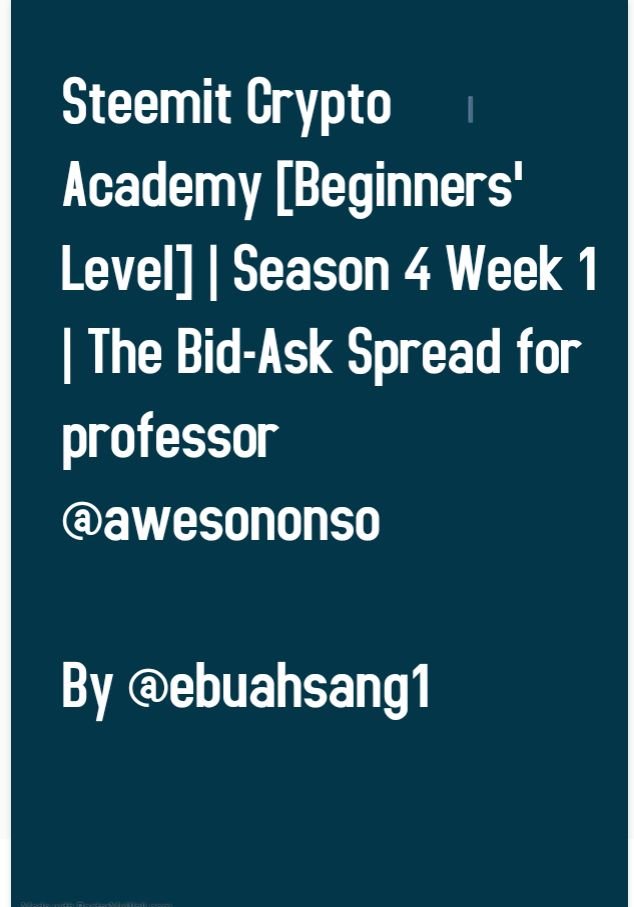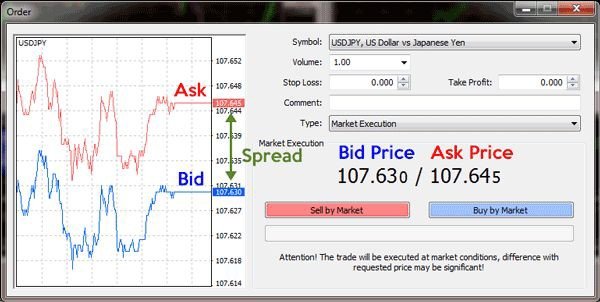Steemit Crypto Academy [Beginners' Level] | Season 4 Week 1 | The Bid-Ask Spread | Homework post for professor @awesononso

Question 1. Properly explain the Bid-Ask Spread.
Inorder for us to properly understand what the Bid-Ask Spread is, it is of utmost importance we understand the two terminology that makes up this word. We will explain what Bid price is and Ask price is.
Bid price.
The Bid price is the highest price in the market at which a trader is willing to buy a financial asset. In a marketplace, a trader looks to buy an asset at the lowest price possible to maximize profit, but in so far as he looks to maximize profit, he has a maximum Price at which he is willing to pay for any financial asset. This is called the bid price
Ask price .
On the other hand, the Ask price is the lowest price a seller/supplier is willing to sell a financial asset in the market. The goal of a seller is to maximize profit and so selling at a higher price is advantageous to the seller. However, the Ask price is the minimum price he is willing to part ways with his financial asset.
What is Bid-Ask Spread.
The Bid-Ask spread is the difference between the price at which a buyer is willing and able to buy a financial asset and the price as which a seller is willing to sell a financial asset. Usually, the Ask price is always above Bid price in the market as traders are looking to make the best profit out of every financial asset in the market.

Pinterest"
Take for example, Carine is willing to buy Steem dollar at $7.68 and willing to sell it at $8.79, the spread in this situation will be
Bid-Ask spread=Ask price-Bid price
Bid-Ask spread=8.79-7.68
=1.11
Regarding the fact that every trader gets into the market for the sake of maximizing profit, traders tend to look for ways to increase the spread. A wider spread means more profit to a trader.
Liquidity and Bid-Ask Spread
The market is run by the forces of demand and supply. Demand is the willingness and ability of buyers to buy at a certain price while supply is the willingness and ability for suppliers to supply at a given price.
Liquidity in a market is when supply and demand in the market are both high, meaning persons willing to buy and sell an asset are readily available in the market.
In a liquid market where there are enough suppliers and buyers, the Bid-Ask Spread tend to be small while in a Less liquid market the Bid-Ask spread is larger due to low trading volume.
Question 2. Why is the Bid-Ask Spread important in a market?
As earlier mentioned, Bid-Ask Spread is the difference between the buying and selling price of a financial asset, this Spread turns to be a very useful instrument in the market measurements.
Liquidity.
One of the most important and vital role of the Bid-Ask Spread is the ability to indicate the liquidity of a financial asset. We earlier mentioned that in a financial market where there are many sellers and buyers, the spread turn to be very small and in a market with fewer sellers and buyers, the spread is higher. So the Bid-Ask Spread range tells a trader the condition of every market.Risk.
Then Bid-Ask Spread is also a good measure of the trading risk involve with any financial asset in the market. The liquidity in the market helps traders to place buy order and sell orders in the market. The higher or larger the Bid-Ask Spread, the higher the risk involve as the asset is not readily tradable and investing might tend to stuck money.Price movement.
The Bid-Ask Spread is also important as it can help traders know the direction of price movement in the market.
Question 3. If Crypto X has a bid price of $5 and an ask price of $5.20,
a.) Calculate the Bid-Ask spread.
b.) Calculate the Bid-Ask spread in percentage.
a.). Calculate the Bid-Ask Spread.
The mathematical representation of the Bid-Ask Spread is as below.
Bid-Ask Spread = Ask Price-Bid price
Therefore, the Spread of the above example will be
Bid-Ask spread= $5.20-$5
= $0.20
b.) Calculate the Bid-Ask spread in percentage?.
The formula to calculate the percentage of Bid-Ask is as follows
Bid-Ask Spread %= (Spread/Ask price) x 100
So according to the spread of $0.20 we had above, the spread percentage is;
Bid-Ask spread %= (0.20/5.20) x 100
=3.846153846153846
Therefore, spread is 3.846( 3.s.f)
Question 4. If Crypto Y has a bid price of $8.40 and an ask price of $8.80,
a.) Calculate the Bid-Ask spread.
b.) Calculate the Bid-Ask spread in percentage.
Using the formula we have above,
a.) Calculate the Bid-Ask spread.
Bid-Ask spread= $8.80-$8.40
Bid-Ask spread=$0.40
b.) Calculate the Bid-Ask spread in percentage.
Bid-Ask spread% = ($0.40/8.80) x 100
Bid-Ask spread% = 4.545454545454545
The Bid-Ask Spread% is 4.545(3.s.f)
Question 5. In one statement, which of the assets above has the higher liquidity and why?
Looking at the calculations from above, it is evidence that crypto X has a Bid-Ask Spread of $0.20 and so it is more liquid than crypto Y with $0.40, this because we said more liquid markets have smaller/lower spreads.
Question 6. Explain Slippage.
Every trader in the crypto currency market understands that you cannot always get the expected outcome. The interaction between demand and supply are the main determinant of price and so with all the indicators in the market, one can still be wrong in his/her speculation. That's why it's said no indicator or analysis is 100% accurate. This is where the term slippagecomes in
Slippage is an unforseen and sometimes unfortunate circumstance that happens in the market. During trading, traders place market orders depending on expected outcome, but things do not always go as planned and the price might deviate from the expected outcome.
Slippage is when prices deviate or change course from the original anticipated outcome and traders need to settle for prices other than the ordered price.
Question 7. Explain Positive Slippage and Negative slippage with price illustrations for each.
There are two types of slippage that can happen in the market, Positive slippage and Negative slippage. We will be discussing more about them below.
- Positive slippage
We already mentioned above that slippage is when price deviate from expected outcome and traders need to settle for prices different from the order price.
Positive slippage is when price deviation favors the trader. In a market, if a trader places a market order to buy, but the actual price where the order execute is is lower than the market order price then we say it is a positive slippage. Also, a market order to sell a financial asset at a given price, if the actual sell price is higher that the ordered sell price, it means the trade was a favorable one.
Let's take for example, a trader place a market buy order of TRX at $0.1030 and due to a slippage in the market the order execute at $0.1025, this becomes a positive slippage as the trader has been favored by the low price at which he is buying.
Buy positive Slippage = Ordered price -Executed Price
=0.1030-0.1025
=0.0005
In the same light, in a sell order, if the trader has placed sell order of TRX at $0.1100 and due to slippage, the Market execute the sell order at $0.1200, the trader benefits the extra increase bin price of TRX
Sell positive slippage= Executed Price - Ordered Price
= 0.1200-0.1100
= 0.0100
- Negative slippage
A negative slippage occurs when the deviation of prices from expected outcome does not favor the trader and traders need to settle for less than the price they were expecting.
We will continue with our TRX example above to throw more light on the negative slippage.
Assuming the current price of TRX which is $0.1037, a trader places a market order to buy at $0.1030 then due to slippage prices change course and the order execute at $0.1040, the deviation of prices has increased the cost price to the trader and is a disadvantage to him.
Buy negative slippage=ordered Price- Executed price
= 0.1030-0.1040
=-0.0010
In case the trader needs to sell, the trader places a market order at $0.1045 and due to price deviation, the market execute the order at $0.1038, this is regarded as a loss and disadvantage to the seller whose order has executed less than the anticipated outcome.
Sell negative slippage= Executed price- Ordered price
=0.1038-0.1045
=-0.0007
Conclusion.
Bid-Ask spread is an important instrument in the market for traders to take note of. It is equally important for traders to note than smaller Spread signifies Lower risk and liquid market while larger spread are less liquid and risky.
I want to thank professor @awesononso for this awesome lecture. I just enjoyed everypart of it. Thank you
CC. Professor @awesononso